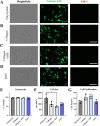An Extracellular Matrix Hydrogel Restores Disc Volume and Alleviates Axial Hypersensitivity in a Rat Model of Disc-Associated Pain
- PMID: 40386495
- PMCID: PMC12081325
- DOI: 10.1002/jsp2.70073
An Extracellular Matrix Hydrogel Restores Disc Volume and Alleviates Axial Hypersensitivity in a Rat Model of Disc-Associated Pain
Abstract
Background: Chronic low back pain is a global socioeconomic crisis, and the majority of those treated for this condition fail to reach long-term remission. Intervertebral disc degeneration is the predominant associative factor in chronic low back pain. Degenerated discs present with mechanical instability, inflammation, and nerve sprouting. Patients treated with spinal stabilizing procedures often report pain alleviation indicating aberrant spinal mechanics, could be causative in the production of pain.
Methods: With this knowledge, a therapeutic was engineered from decellularized healthy porcine nucleus pulposus tissue mixed with type I collagen and a chemical crosslinker, genipin, to treat mechanical instability and pain.
Results: In vitro, this hydrogel, termed dNP+, was spontaneously fibrillogenic at 37°C and cytocompatible with primary human disc cells and exhibited the capacity to improve the intervertebral disc storage modulus after injury. In vivo, in a rat model of discogenic low back pain, dNP+ proved effective at restoring degenerated disc volume, decreasing axial hypersensitivity, and decreasing spontaneous pain-like behavior when administered 9 weeks after disc degeneration was initiated. However, dNP+ did not alter nerve presence or restore disc morphology when compared to injured discs.
Conclusion: Conclusion: Altogether, the data collected in this study concluded that dNP+ was an effective treatment for pain-like behavior in a robust animal model of chronic disc-associated low back pain.
Keywords: decellularized tissue; disc degeneration; disc‐associated pain; genipin; low back pain.
© 2025 The Author(s). JOR Spine published by Wiley Periodicals LLC on behalf of Orthopaedic Research Society.
Conflict of interest statement
David J. Lillyman and Rebecca A. Wachs are currently pursuing a patent application for the dNP+ material, US Patent App. 18/445466.
Figures










References
-
- James S. L., Abate D., Abate K. H., et al., “Global, Regional, and National Incidence, Prevalence, and Years Lived With Disability for 354 Diseases and Injuries for 195 Countries and Territories, 1990–2017: A Systematic Analysis for the Global Burden of Disease Study 2017,” Lancet 392, no. 10159 (2018): 1789–1858. - PMC - PubMed
-
- Martin B. I., Deyo R. A., Mirza S. K., et al., “Expenditures and Health Status Among Adults With Back and Neck Problems,” Journal of the American Medical Association 299, no. 6 (2008): 656–664. - PubMed
LinkOut - more resources
Full Text Sources

